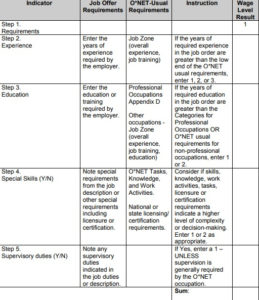
What’s the Wage Again – Determining the Right H-1B Wage Level
For employers who are looking to hire an H-1B worker, the first step of the process is to file a labor condition application (LCA) with the Department of Labor (DOL). This LCA has very basic information like the company name and contact information, the job code, the job title, work locations, salary, and other regulatorily required statements. One of the items that employers have to decide is what is the proper wage level to pay the employee, not just the salary, but the actual wage level. Like most things in employment-based immigration, this isn’t just as simple as checking a box, and requires detailed analysis to ensure the wage level is correct.
DOL has created guidance for determining the proper wage level, and the “calculus” that employers should be doing to determine the wage level. There are 4 wage levels. They are defined as:
Level I (entry) wage rates are assigned to job offers for beginning level employees who have only a basic understanding of the occupation. These employees perform routine tasks that require limited, if any, exercise of judgment. The tasks provide experience and familiarization with the employer’s methods, practices, and programs. The employees may perform higher level work for training and developmental purposes. These employees work under close supervision and receive specific instructions on required tasks and results expected. Their work is closely monitored and reviewed for accuracy. Statements that the job offer is for a research fellow, a worker in training, or an internship are indicators that a Level I wage should be considered.
Level II (qualified) wage rates are assigned to job offers for qualified employees who have attained, either through education or experience, a good understanding of the occupation. They perform moderately complex tasks that require limited judgment. An indicator that the job request warrants a wage determination at Level II would be a requirement for years of education and/or experience that are generally required as described in the O*NET Job Zones.
Level III (experienced) wage rates are assigned to job offers for experienced employees who have a sound understanding of the occupation and have attained, either through education or experience, special skills or knowledge. They perform tasks that require exercising judgment and may coordinate the activities of other staff. They may have supervisory authority over those staff. A requirement for years of experience or educational degrees that are at the higher ranges indicated in the O*NET Job Zones would be indicators that a Level III wage should be considered.
Frequently, key words in the job title can be used as indicators that an employer’s job offer is for an experienced worker. Words such as ‘lead’ (lead analyst), ‘senior’ (senior programmer), ‘head’ (head nurse), ‘chief’ (crew chief), or ‘journeyman’ (journeyman plumber) would be indicators that a Level III wage should be considered.
Level IV (fully competent) wage rates are assigned to job offers for competent employees who have sufficient experience in the occupation to plan and conduct work requiring judgment and the independent evaluation, selection, modification, and application of standard procedures and techniques. Such employees use advanced skills and diversified knowledge to solve unusual and complex problems. These employees receive only technical guidance and their work is reviewed only for application of sound judgment and effectiveness in meeting the establishment’s procedures and expectations. They generally have management and/or supervisory responsibilities.
In addition to defining the different wage levels, DOL has a formula for determining the proper wage level in an LCA through the use of a matrix. There are ultimately five steps employers have to go through to compare the offered position to the O*NET for the position (https://www.onetonline.org/). The matrix to use and the instructions are below.
You will always start with level 1, because, that is the lowest. From there, you will go through each step and compare it to the O*NET.
Step 2 is likely the most complicated. For this, you will have to review the experience the employer requires and compare it to the O*NET experience for that position. The O*NET provides various job zones for each type of position, and the DOL gives guidance based on the Job Zone. Most H-1B jobs will fall under the guidance for occupations in Job Zones 2 through 5. For this, you will review the employer requirement and if the employer’s experience requirement is:
- At or below the level of experience and SVP range, make no entry in the Wage Level Column.
- In the low end of the experience and SVP range, enter a 1 in the Wage Level Column.
- In the high end of the experience and SVP range, enter a 2 in the Wage Level Column.
- Greater than the experience and SVP range, enter a 3 in the Wage Level Column
As an example, the software developer SOC Code is Job Zone 4, and the SVP range is 2-4 years of preparation. So, if an employer requires 2 years of experience, no entry is required. However, if the employer requires 5 years of experience, you would enter 3 in the wage level column. Four years of experience would net a 2 in the wage column.
Step 3 requires you to look at the education the employer requires and the O*Net. Here, if the education required is equal to or less than what is usually required on O*NET, no entry is made. If it is more than what is usually required, you add a 1. And, if the education is more than the level described by what “some may require” based on the O*NET, you add a two.
As an example of Step 3, the software developer position states that “most of these occupations require a four-year bachelor’s degree, but some do not.” So if the employer requires a master’s degree for the position, you will add a one.
Step 4 requires employers to look at any special skills required. Does the position require any specific certificates, multiple licenses (more so than the usual requirement for that position), or truly unique skills, you will add a point or points.
Step 5 is based on whether the employee supervises other employees as part of their normal job duties. Note, if the position is supervisory in nature, you do not have to add a point. So for example, if a senior software developer supervises other employees, you will need to add a one. However, you would not have to add a one to the worksheet for a computer and information systems manager, because that is a managerial position.
Once you have completed the worksheet, you will add up the points to determine the wage level. Of course, even if you get a number higher than 4, you would max out at wage level 4 as there are only four wage levels.
It is important the employers select the right wage level when initiating an H-1B case. USCIS and DOL have increased their scrutiny in that matter and site visits can lead to negative information that may impact that validity of the LCA. It is worth coordinating with your business immigration attorney to select the right wage level when starting an H-1B case.
By: Steven Brown
Steven Brown is a Partner at Reddy Neumann Brown PC where he works in the Non-immigrant visa department and leads the Litigation Team. His practice covers all phases of the non-immigration visa process including filing H-1B, L-1, E-3, H-4, and H-4 EAD petitions. In the last two years, Steven has successfully handled over 1,000 non-immigrant visa petitions including filing petitions, responding to any necessary Requests for Evidence, and drafting motions and appeals. He has also become a key resource for F-1 students that seek guidance on properly complying with the F-1 visa regulations and any OPT or CPT issues they may have. Additionally, Steven holds a weekly conference call for companies that are part of one of the largest organizations for IT Services companies in America.
Reddy & Neumann has been serving the business community for over 20 years and is Houston’s largest immigration law firm focused solely on US. Employment-based immigration. We work with both employers and their employees, helping them navigate the immigration process quickly and cost-effectively


